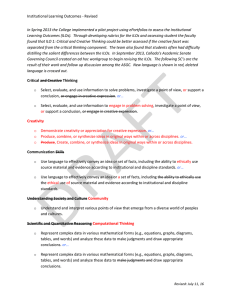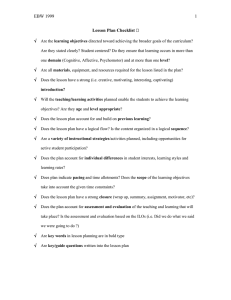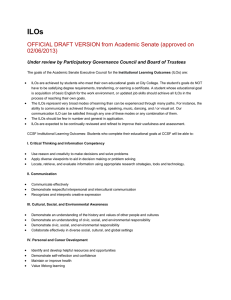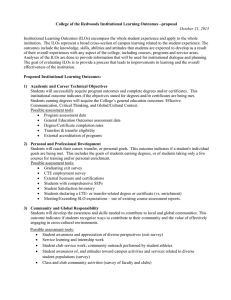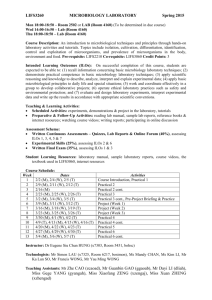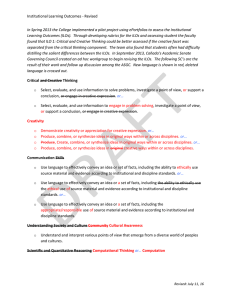Guidelines for Programme and Course Design and Review Revised January 2014
advertisement
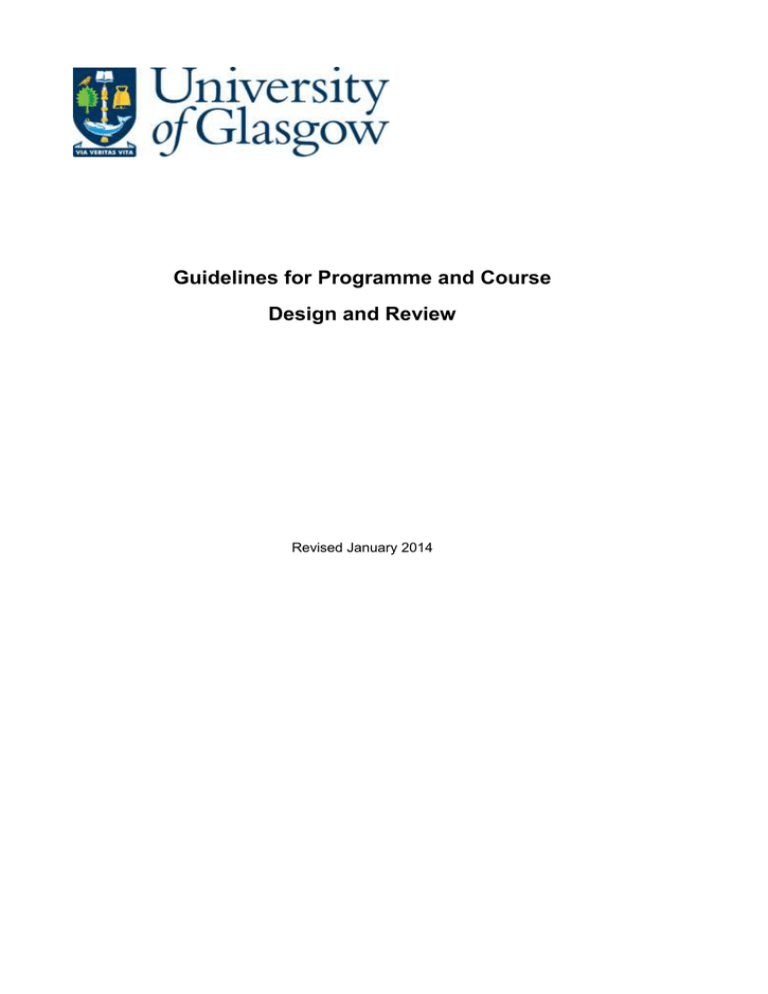
Guidelines for Programme and Course Design and Review Revised January 2014 CONTENTS 1. Introduction ........................................................................................................ 3 2. Key steps in programme and course design ...................................................... 4 3. Reviewing programmes or courses .................................................................... 7 4. Writing aims and intended learning outcomes .................................................... 8 5. Designing an assessment and feedback strategy ............................................ 12 6. Deciding on teaching methods and student learning activities ......................... 13 Appendix 1 Questions to guide programme/course design and review ................ 16 Appendix 2 Active verbs based on Taxonomy of Cognitive Learning ............. Error! Bookmark not defined. 2 1. Introduction As a university we are committed to providing a learning experience which is: informed by the latest research and developments within our disciplines; international in outlook; and inclusive of the needs of our diverse student body. This document aims to provide guidance on programme and course design that is both practical and informed by the strategic priorities set out in the University’s Learning and Teaching Strategy (2011-15). Any new programme or course, or major revision to existing provision, needs to reflect these strategic priorities and meet the requirements of our diverse student body. It also needs to be informed by good practice in programme/course design. As a research intensive institution, our Learning and Teaching Strategy emphasises the importance of research led teaching. When designing and reviewing programmes and courses it is important to consider how you will integrate opportunities for students to be exposed to and involved in the latest research. There has been significant recent research activity investigating the connections between research and teaching – often referred to as research-teaching linkages. This work investigates the ways in which the full range of a subject area’s research activity informs both learning within the discipline and the broader student experience of studying. In order to create effective links between research and teaching, staff need to develop creative ways of authentically aligning research priorities with the needs of student learning. The fostering of “research-mindedness” from the formative years of university studies can serve to empower and engage the student whilst personalizing their experience and promoting research skills which will be useful for future professional roles (Land & Gordon, 2008). See the QAA Scotland Enhancement Themes Website for further resources on research-teaching linkages. When considering how to design a programme or course that supports the integration of research and teaching, you might wish to consider the following questions: How does research link with teaching in your School? How could these research-teaching linkages be enhanced further? How can you best support the development of students’ skills in enquiry, critical analysis and research? It is likely that in the first instance the immediate link between research and teaching will be course content. However, you may also want to consider whether the programme or course could contain elements that stimulate students to adopt disciplinary research approaches or to undertake research activities? The University is committed to providing excellent opportunities for students to develop their knowledge, skills, academic abilities and personal qualities within their chosen discipline as well as across disciplines during their time at the University of Glasgow. This is reflected in the University’s Graduate Attributes which states our aspirations that students will become: subject specialists; investigative; independent and critical thinkers; resourceful and responsible; effective communicators; confident; adaptable; experienced collaborators; ethically and socially aware; reflective learners. Actively embedding graduate attributes within your programme and course design ensures that students develop a range of abilities that will prepare them for the immediate demands of their current studies as well as for future study and employment. Embedding graduate attributes within programme and course design also helps students to appreciate the broader significance of their everyday studies to their overall personal development, enhancing motivation and engagement with their learning. 3 Sources of advice This document is intended to offer you guidance for programme and course design and review. If you need further advice, the Academic Development Unit have a specific ‘College Contact’ for each College and they will be happy to advise and support you on all aspects of programme and course design. 2. Key steps in programme and course design 1. First set up a programme/course design team. If you are planning to design a course on your own, it can still be helpful to identify peers who can provide you with feedback on your plans. Consider whether students or other stakeholders could/should be involved in the design team. 2. Gather together all the relevant documentation to help you with your design and particularly those documents that you will need to fill out as part of the programme/course approval process. These include: Programme/course approval documents Degree regulations – University Calendar Course Catalogue Guidelines on writing Programme Specifications Code of Assessment – Guidance Code of Assessment (in University Calendar) Subject benchmark statements Scottish Credit and Qualifications Framework levels and descriptors Code of Practice on Obtaining and responding to feedback from students Any relevant frameworks/publications from professional, statutory or regulatory bodies 3. Identify the key stakeholders you will need to consult with or involve in your planning. It is particularly important that you involve/consult with all members of staff who will deliver the courses and programmes you are proposing or changing so they gain ownership over any changes or new provision. Other stakeholders could include past, potential and current students, employers, professional contacts, external examiners, student advisers, and so on. With the current emphasis on student partnership to enhance the student learning experience, it is very important to engage students in some way whether through gathering feedback from previous students about existing provision, whether consulting students about proposals, or involving them in more collaborative ways in designing their own programmes and courses. Please note consultation with stakeholders is a requirement, collaborative course and programme design is optional. 4. Set up relevant mechanisms and processes with stakeholders to undertake the consultation/collaborative planning. 4 5. Clarify whether the existing learning environment provides adequate resources to support your planned programme/course and identify any areas needing to be addressed. For example, consider staffing, library resources, ICT provision, teaching/learning spaces, administrative support, learning support, timetabling limitations, and so on. 6. Identify who your prospective students are likely to be and what profiles they are likely to have. What sort of educational backgrounds will they come from? What sort of cultural background will they have? (see the internationalisation information sheet for more ideas here) What qualifications are they likely to have? What sort of experience will they have? What needs might they have in relation to your programme/course? What prior knowledge/skills would they need in order to participate in the programme/course? What entrance level requirements will you set? Use this information to inform what you need to do to best support the different needs and levels of experience/knowledge that your students may have, and try to make your curriculum and course resources inclusive of all your students. If you have any concerns about accessibility of, for example, your reading lists, you may wish to consult with library staff for advice on good practice in this area. 7. Check out the likely market for your proposed programme/course (staff in the Recruitment and International Office and in the Careers Service can offer you support and advice). Who are your likely students? What would be their likely career destinations? Will you aim to attract international as well as home students? How sustainable is the likely pool of applicants you would draw from? 8. Check out similar programmes and courses that are already running to clarify what will be distinctive about your provision. Consider not only the subject matter but also how the teaching approach, assessment methods and learning experiences will create a stimulating and engaging environment for students that will help them to develop a range of graduate attributes. 9. Allocate time to work out an informative name for your programme/course. Write aims and intended learning outcomes (ILOs) for the programme/course (see section 4 of this document for guidance on what aims and ILOs are, and also for details of how to write good quality aims and learning outcomes). Include consideration here of the key content/topic areas and what it is that the programme/course will enable participating students to know and be able to do as a result of engaging in the programme/course. Consider carefully which graduate attributes you want a graduate of your programme/course to develop. Use your intended learning outcomes to ensure that students will be assessed on their achievement of the key knowledge and skills you wish them to develop. For example, think carefully about the research-teaching linkages within your programme/course and how these links will help students develop their investigative skills or their ability to learn independently. Creating well written aims and intended learning outcomes (and assessments that are well aligned with these) will help you to ensure your provision is fit for purpose. It is worth taking the time to consider what you really want your students to achieve (see for example the University’s graduate attributes matrix), and how you can ‘design in’ a range of other key factors that can help 5 engage your students. Use the available supplementary information sheets that cover a range of key issues that should inform your design. Also refer to QAA subject benchmark statements any relevant professional, statutory and regulatory bodies (PSRBs), and the Scottish Credit and Qualifications Framework (SCQF). Aims and ILOs need to be written for the whole programme as well as for each course within the programme. A taught degree programme (whether at undergraduate or postgraduate level) needs to be designed in such a way that its component courses support a coherent learning experience for the student, which progressively builds towards achievement of programme ILOs. Because all assessment at the University of Glasgow is conducted at course level, there needs to be a clear alignment between programme and course level ILOs, and care needs to be taken to ensure that all programme ILOs are assessed somewhere in the individual courses that make up the programme. 10. Design an assessment and feedback strategy which aligns with your programme/course aims and ILOs. In other words, the assessment strategy needs to encourage the kind of learning approach you want your students to adopt, provide students with regular opportunities for constructive feedback, and provide a range of tasks which best allow your students to demonstrate their achievement of the ILOs. Further information on designing assessment is provided in section 5, but it is also worth consulting the University’s Assessment Policy and associated Guide to the Code of Assessment. 11. Identify teaching methods and learning activities most appropriate to enabling your students to achieve the programme/course aims and ILOs. In other words, the methods and learning activities you adopt need to align with the ILOs of the programme/course. Further information about different teaching methods and learning activities can be found in section 6. 12. Work out how the different elements of your design integrate together in order to form a coherent programme/course which supports student progression towards the achievement of the aims and ILOs. For example, consider the sequencing of the introduction of new material and tasks so that the student is supported in going from material which is simpler and/or more familiar to the more complex/less familiar. Build in opportunities for revisiting content and processes. Include here when and how you will provide academic support for students and how you can integrate formative activities within the programme/course which enable students to develop their academic practice in relation to information seeking and management, note-taking, referencing, reading, writing, presentations and discussion. 13. Consider how best to use the Moodle Virtual Learning Environment to support your programme/course and the electronic personal development planning tool Mahara, or other relevant electronic tools to support learning. See available Guidance on Moodle and Guidance on Mahara documents for further information. 14. If you are working at the programme level, you will need to develop a programme specification. If you are working at the course level you will need to develop course specification documents available within the Programme Information Project (PIP) system. These template documents are the required documents to use when seeking approval for new programmes and courses. They are also the documents that will need updating if you are reviewing existing provision. These documents provide a framework within which to communicate and record the key features of any programme/course including your aims and ILOs, and how your assessment strategy and teaching methods/learning activities align with these. It should encompass the intended knowledge, understanding, skills and other attributes that students will have developed on successfully completing a specific programme/course. It needs to be written in a 6 manner that is readily understandable by current and prospective students. Programme specifications also provide details of the different points at which a student can leave the programme with a qualification. 15. Develop an evaluation strategy to inform the future development of the programme and to build in opportunities for obtaining and responding to student feedback throughout the implementation of the programme/course. This will involve the collection and assembly of data from a variety of sources, for example, student feedback questionnaires, external examiners’ reports, annual monitoring reports, student focus groups, employer feedback, and professional body feedback. The evidence collected needs to be evaluated against the stated aims and outcomes of the programme/course and if necessary revisions made to the provision (please note that some of these changes may require approval through the usual procedures required for programme/course changes). Where you are planning new or innovative teaching and learning approaches consider using this as the basis for scholarly or research activity. Your work may address useful educational research questions and may be worth disseminating within or outside the University. You also need to include details of how students will be informed of, or involved in, any adaptations and actions that are made in response to their feedback. See the University’s Code of Practice on Obtaining and Responding to Student Feedback for more guidance on this. The review of courses and programmes that is necessary for completing Annual Monitoring Reports is obviously an existing process that can inform the development of future programme/course provision. 16. Fill out all relevant programme/course approval documentation and submit them to the relevant College committee for approval using the University’s Programme Information Project (PIP) online system. For further details, guidance and access to appropriate forms see the Senate Office web pages on Programme and course approval. Please see Appendix 1 for a useful list of questions to guide you in the design and review of programmes and courses. 3. Reviewing programmes or courses1 The following questions offer guidance on the key issues to consider when reviewing a programme or course: 1 Have changes made to a programme or course over time affected its original purpose? Are there still appropriate resources available to support the programme or course? Does the programme/course need to take account of recent developments in research, technology, and teaching and learning? Are there any changes to external reference points, such as benchmark statements, the Scottish Credit and Qualifications Framework, and/or relevant professional and other bodies which need to be taken account of? Are there any changes in student demand, employer expectations and employment opportunities? Are there any changes to who your students are and do you need to adapt the programme/course in any way to respond to these changes to ensure your provision remains relevant? Are there any strategic initiatives which have been introduced since the programme or course was first implemented which now need to be taken account of? How might student retention and progression data inform the review process? Adapted from QAA (2006) Code of Practice on Programme Design, Approval, Monitoring and Review 7 How might National Student Survey findings and any other relevant survey data inform the review process? What key issues have been raised in student feedback over the last three to five years that need to be taken account of in enhancing the programme or course? Have you considered involving students in the review of programmes/courses? Do the programme/course aims, ILOs, assessment strategy and teaching methods need to change as a result of this review? 4. Writing aims and intended learning outcomes Although many people start by considering what will be taught in a course, a more effective approach to course design that results in better alignment between the different elements of a course/programme is if you approach design in the following order: (1) aims, (2) ILOs, (3) assessment and (4) learning and teaching methods. Aims Aims are the broad intentions of a course/programme. These are usually stated in terms of the opportunities that the course/programme will offer students. Example (Education) The aim of this programme is to provide participants with the opportunity to develop confidence and skills to apply basic principles of adult learning in different contexts. Example (Psychology) The aim of this course is to introduce students to core material in the area of biological, cognitive and experimental Psychology broadly defined, including exposure to the conduct of experimentation, data gathering and analysis. The course also teaches practical skills involved with experiments employing human participants, focusing on research design, statistical analysis, and professional standards in the communication of research findings. Intended learning outcomes (ILOs) ILOs describe what a student should be able to demonstrate by the end of the course/programme. They will be assessed and therefore must be stated specifically and clearly. They should focus on content knowledge; disciplinary skills; graduate attributes; and values. They should be achievable but require increased levels of knowledge and skills as the students’ level of study increases. ILOs are expressed using a stem (that gives a time limitation) followed by a statement that begins with an active verb (outlining what students will be able to demonsrate) + object (what is to be learned) + a qualifying phrase (that provides the context and degree of mastery expected). Example (Physics and Astronomy) By the end of the course students will be able to: Explain how the modern view of the orbits of planets and other bodies developed in the context of the Copernican revolution and Newton’s mechanics. Example (Modern Languages and Cultures) By the end of this course students will be able to: produce sustained arguments in both written and oral form on a variety of textual sources relating to postcolonial literature, thought and visual culture. Example (Veterinary medicine) By the end of this course students will be able to: Describe the anatomy (including histology) and give a functional account of all of the major body systems in a variety of companion and farmed animals. 8 Things to consider when writing aims and ILOs: What knowledge, skills, values and attributes do your students already have when they enrol on the course/programme? What knowledge, skills, values and attributes do you want them to develop? What will students need to do to demonstrate that they have achieved the ILOs? Ensure that course ILOs are consistent with, and contribute towards, programme ILOs. Try to avoid using verbs such as understand, appreciate, be familiar with, and know in ILOs as these verbs do not clearly indicate what level of understanding or knowledge a student must demonstrate in an assessment. See Blooms taxonomy below to illustrate different levels of knowledge and understanding. It is fine to use the same active verb more than once in the ILOs if it is expressing what you want students to be able to achieve. Aims and ILOs will be used by both staff and students and should help to ensure clarity about the purposes and intended outcomes of courses/programmes Try to restrict your ILOs to approx 4-6 ILOs for a 20 credit course* *If you have many content-related ILOs, consider whether every element needs a separate ILO Example Rather than writing: ‘By the end of this course you will be able to: recognise the symptoms and devise an appropriate treatment plan for pneumonia recognise the symptoms and devise an appropriate treatment plan for emphysema recognise the symptoms and devise an appropriate treatment plan for acute bronchitis’ …consider writing: By the end of this course you will be able to: recognize the symptoms and devise an appropriate treatment plan for a range of respiratory conditions (see Appendix A) Then list the different respiratory conditions in Appendix A that you expect your students to recognise and be able to treat and any of which they may be assessed on. Blooms Taxonomy (Bloom et al, 1956) 9 Other sources of information and help writing aims and ILOs: Academic Development Unit College Contacts can offer help in writing aims and ILOs: http://www.gla.ac.uk/services/learningteaching/allocatedcollegecontacts/ QAA Subject benchmark statements – set out expectations and standards of degrees in the different disciplines: http://www.qaa.ac.uk/assuringstandardsandquality/subject-guidance/pages/subjectbenchmark-statements.aspx QAA (2011) UK Quality Code for Higher Education, Chapter B1 Programme Design and Approval. http://www.qaa.ac.uk/Publications/InformationAndGuidance/Documents/Quality-CodeChapter-B1.pdf Active verbs for different levels of Bloom’s Taxonomy Knowledge define repeat record list recall name relate underline Comprehensio n translate restate discuss describe recognise explain express identify locate report review tell Application interpret apply employ use demonstrate dramatise practice illustrate operate schedule sketch Analysis distinguish analyse differentiate appraise calculate experiment test compare contrast criticise diagram inspect debate question relate solve examine categorise Synthesis compose plan propose design formulate arrange assemble collect construct create set up organise Evaluation judge appraise evaluate rate compare revise assess estimate manage prepare This guidance on writing aims and ILOs, is consistent with one of the most common models of course design used by academic staff in UK Universities - the constructive alignment model (Biggs, 1996; Biggs 2003). This model is described as ‘constructive’ because it is based on the constructivist theory of education where learners are considered to create their own knowledge and meanings by making sense of experiences and new information in relation to their existing understandings. New and adapted understandings are constructed as they assimilate and interpret new knowledge and experience. The model uses the term ‘alignment’ to emphasise the importance of all the elements of course design being coherent. For example, if the aims of a course are for a student to develop a practical skill 10 such as driving a car, the assessment will need to test that a student can actually drive and therefore, a well-aligned assessment would involve a practical test of driving skill. Similarly, well aligned teaching methods would provide students with an opportunity to develop practical driving skills. The constructive alignment model focuses on designing courses by starting with a focus on the broad aims of a course and what the intended learning outcomes will be for students. It then requires consideration of how you will assess that students have achieved the intended learning outcomes. The early focus on assessment mirrors the behaviour of many students who are ‘assessment-led’ in their orientation to study. So the early focus on assessment when designing courses taps into the potential that assessment has as a motivator for student learning. Assessment should therefore be considered as an opportunity for students to learn – not simply as a test of what they have learned. The assessment strategy should support learning at the intended level and enable students to demonstrate their learning at this level. See Table 1 for examples of aligning ILOs with assessment and with learning and teaching tasks Table 1: Aligning ILOs with assessment and teaching/learning activities ILO By the end of this course you should be able to: evaluate practical solutions to problems in adult education practice design an experiment to demonstrate horizontal transmission in a haploid organism (e.g. E.coli) make valid comparisons between different parts of Europe and across different historical periods on the basis of sound historical evidence Assessment tasks Teaching/learning tasks Case study of an issue in practice which the student has to propose solutions for Discussion of practice case studies Portfolio in which student gives a critical account of their own practice focusing on issues and proposed solutions Short answer essay on the transmission genetics of a haploid organism Assessed practical work designing an experiment to demonstrate horizontal transmission A debate paper in which two students take a position and have to argue their case to their seminar colleagues, take a vote, and submit their argument in writing, noting the outcome of the vote and anything extra they learned from the debate. Supervised work placements Lectures and inquiry-led laboratory classes A series of lectures covering the topic/period A discussion seminar using primary sources and a general secondary text provide an overview Recommended readings More specifically, this outcomes-based approach helps students to: 11 determine what they are meant to be achieving; monitor their own progress towards their goals; take greater control over their own learning; and thus become more self-directing as learners. A further rationale for adopting an outcomes-based approach is provided by the fact that the University's Code of Assessment is based on the extent to which students can demonstrate achievement of course ILOs, “course ILOs are intended to be those in respect of which it is reasonable to claim that all students have been assessed.” (Guide to the Code of Assessment, p. 3) It is therefore essential that programme and course ILOs are expressed clearly and in such a way that they can be assessed. It also means that assessment strategies and tasks have to clearly allow all students to demonstrate to the best of their abilities through their achievement of the ILOs. 5. Designing an assessment and feedback strategy Assessment performs two functions – support for learning and accreditation of learning. Assessment for learning uses assessment tasks as a means of providing students with formative feedback and engaging students in activities which are in themselves learning activities. Assessment of learning uses assessment tasks to judge performance and award credit for the level of achievement a student attains through a course or programme. Assessment is also crucial in the student’s experience of the curriculum. Students will judge what it is that they have to learn, the level at which they should learn and how they should learn, on the basis of the assessment strategy of a course or programme. This means that if the assessment strategy is not aligned with the ILOs, the student is most likely to focus on the assessment strategy to guide their learning rather than on the ILOs. It is therefore essential in good programme or course design to get the assessment strategy right and to make sure it is aligned with the aims and ILOs of the programme and course. Therefore it is worth considering the following questions: What formative assessment tasks will best enable students to achieve the programme/course ILOs? (formative assessment is assessment that does not count towards a final mark and usually is used to provide feedback to students on their progress and that enables them to adapt their approach to enhance their learning and assessment outcomes. What is the optimal sequence and timing of formative tasks to best enable students to achieve the ILOs? In other words, what sequencing and timing of tasks will provide students with the most timely and useful feedback to support their learning of the ILOs? What summative assessment task(s) will best enable students to demonstrate their achievement of the ILOs? (summative assessment refers to assessments that count towards a student’s marks) Criteria for designing an effective assessment strategy2 The following is a summary of key criteria for designing an effective assessment strategy: Adapted from Centre for the Study of Higher Education ‘Core Principles of Effective Assessment’, www.cshe.unimelb.edu.au/assessinglearning Australian Universities Teaching Committee and Assessment Reform Group (2002) Assessment for Learning – 10 Principles, Nuffield Foundation, http://arrts.gtcni.org.uk/gtcni/bitstream/2428/4623/1/Assessment%20for%20Learning%20%2010%20principles.pdf 2 12 Integrate assessment across the programme/course rather than see assessment as an add-on to be undertaken at the end Design assessment tasks which promote learning and good academic practice Assess understanding and higher order learning (such as analysis, synthesis and evaluation) rather than just recall Use a variety of assessment methods in order to minimise the disadvantages of each, and in order to provide individual students (who will have different strengths and learning approaches) with a range of opportunities to demonstrate their achievement Assess transferable skills as well as knowledge and understanding Build in progressive complexity and demands across the programme of study Begin with ‘low-stake’ small-scale tasks that provide timely and pertinent feedback Motivate students by emphasising progress and attainment rather than failure Provide students with choice over assessment tasks Consider whether you can involve students in design of assessments or negotiation of marking criteria Build in opportunities for self and peer assessment Take account of the workload implications for students and staff of the timing of assessment tasks and avoid over-assessment Include frequent opportunities for feedback. Make sure that feedback is sensitive and constructive and indicates what was good and why, what was wrong/inappropriate and why, and how the work could be improved. Do not rely on grades for feedback Make sure that certain groups of student are not disadvantaged through the design or content of an assessment task Minimise the possibility of plagiarism through the way you design assessments See also the University’s Guide to the Code of Assessment, (particularly sections 1.2 and 1.3) 6. Deciding on teaching methods and student learning activities University teaching is often characterised by five main teaching/learning methods: lectures, problem or discussion-based seminars/tutorials, laboratory work, fieldwork, projects and dissertations. There are of course some additional methods specific to disciplines such as clinical teaching. It is therefore easy when designing a new programme or course to adopt a combination of these methods without clearly thinking through whether they are the optimal ways in which students will learn the necessary knowledge and skills to be able to achieve the ILOs. When considering what methods to use, where possible, choose methods which encourage active forms of student-centred, enquiry-based learning. In student-centred learning, students are active in the process of learning, leading to students taking on greater responsibility for their learning and there is greater interaction and interdependence between the teacher and students (O’Neill and MacMahon, 2005). Enquiry based learning methods encourage the student to actively seek answers to meaningful, course-relevant questions rather than simply having information presented to them. Such methods also support research-teaching linkages and the development of graduate attributes. They help build the student‘s confidence, openness to others’ views, and tolerance of ambiguity. This motivates students to independently seek out answers to questions and thus supports the development of autonomous lifelong learning. These methods also promote social interaction with peers, teaching staff, researchers and the School. 13 It is also important to expose students to a variety of teaching approaches and learning activities to appeal to different students’ learning approaches. Exposing students (and staff) to a broader range of teaching and learning experiences can help to enhance our shared aspirations of what might be possible in terms of excellent teaching and also enhances our meta-cognitive understanding of the processes of our own and others’ learning. Appendix 3 provides a summary of pedagogic principles which support the achievement of an enquiry-led, international and inclusive curriculum. This can also act as a checklist against which to review programme/course design. General methods and approaches to student-led learning include: Problem- based learning (PBL) The learning process is organised around problems. The idea is that any course starts with a scenario or series of problems that are related to ‘real-world’ professional issues rather than academic subjects. PBL has been used in medicine, architecture, sciences, engineering and agriculture. Project-centred learning Whereas in problem-based learning the overall goals and the problems are set by the teachers, project-based learning requires students to set their own learning objectives, decide on their own learning strategies and, in some instances, propose what they want to be assessed on. Undergraduate honours dissertations, or inter-disciplinary student projects are examples of this. Experiential learning The starting point in this approach is a real or concrete experience which the student is a part of, actively explores, and notes what is happening. The experience is then mulled over in the phase of critical reflection, followed by a period of drawing generalisations and theorising about what the experience meant. Individualised learning The main thrust of individualised learning is that it emphasises the work of one student rather than a group or a class. It usually allows the students to progress at her/his own pace within certain time constraints, and to test their own progress when they feel ready for it. For example the Mathematics Level 1 course provides students with online tests which highlight areas for improvement. These tests can be sat as many times as students would like and are supported by drop-in sessions. Table 4 indicates the types of methods best suited to supporting five key generic higher education learning outcomes. 14 Table 2: Teaching and learning methods (adapted from Bourner, 1997 and Biggs, 2003) Knowledge Teacher directed activities Lectures Guest lectures Concept mapping Modelling through thinking aloud Electronic voting systems (EVS) Student directed activities Information searching tasks Directed private study Elaborating, analysing and applying knowledge Case studies Practicals Laboratories Demonstrations Experiments Simulations Discussion Debate Seminars and tutorials Supervision Computer mediated discussion Projects Problem based learning Essays Work based learning Group work Student presentations Student led seminars Literature reviews Peer assessment Student mentoring Peer assisted learning Self assessment Learning aims Generating ideas and evidence Personal development Workshops Brainstorming Laboratories Practicals Fieldwork Discussion Experiments Supervision Feedback Learning contracts Role play Mentoring Coaching Experiential learning Enquiry-based learning Research projects Dissertations Group work Mind-mapping Problem solving Inter-disciplinary projects Service learning Student-organised events Reflective journals Self assessment Planning and managing own learning PDP Learning logs Projects Independent study Dissertations Work placements Portfolio development References Biggs, J. (1996) Enhancing teaching through constructive alignment. Higher Education 32 347-364. Biggs, J. (2003) Teaching for Quality Learning at University, 2nd edition, Buckingham: SRHE/Open University Press. Bloom, B.S., Engelhart, M.D., Furst, E.J., Hill, W.H., Krathwohl, D.R. (1956) Taxonomy of educational objectives: The classification of educational goals. Handbook I: Cognitive domain. New York: David McKay Company. Also see Atherton, J.S. (2013) Learning and Teaching; Bloom's taxonomy: http://www.learningandteaching.info/learning/bloomtax.htm Bourner, T. (1997) Teaching methods for learning outcomes, Education and Training, 39: 9, pp. 344-348. Land, R. & Gordon, G. (2008) Research-Teaching Linkages: Enhancing Graduate Attributes, Quality Enhancement Themes Project Report. Glasgow: QAA. O’Neill, G. and McMahon, T. (2005) Student-centred learning: what does it mean for students and lecturers? In O’Neill, G., Moore, S. and McMullin, B. (Eds) Emerging issues in the practice of university learning and teaching. Dublin: AISHE. Quality Assurance Agency for Higher Education ( 2006) Code of Practice for the Assurance of Academic Quality and Standards in Higher Education, Section 7 Programme Design, Approval, Monitoring and Review. 2nd Edition. September. Mansfield: QAA. 15 Appendix 1 Questions to guide programme/course design and review Adapted from QAA Code of Practice on Programme Design, Approval, Monitoring and Review, (2006) Key areas Yes No Comments Action to be taken Aims and ILOs Are aims and ILOs clearly stated? Are aims and ILOs clearly communicated to students, staff and external examiners? Are ILOs aligned with aims? Do the aims and ILOs of individual courses support the achievement of programme aims and learning outcomes? Do the content, teaching methods and the learning opportunities provided best enable students to achieve the aims and ILOs? Does the assessment strategy adopted best support student learning and enable students to demonstrate their achievement of aims and ILOs? Do aims and ILOs reflect current knowledge and research? Are aims and ILOs informed by relevant subject benchmark statements and/or PRBs requirements? Attention to contextual influences Does the design of the programme/course reflect best practice? Does the design of the programme/course take account of the needs of the student target group? Does the programme/course take account of the University’s Learning and Teaching Strategy priorities? How does research inform the curriculum of the programme? 16 Key areas Yes No Comments Action to be taken Level Do the ILOs clearly reflect the level of study? How does the level of the programme/course fit with the Scottish Credit and Qualifications Framework? Progression Do the demands on the student increase over the course of the programme? Are the programme and its component courses designed and organized in such a way as to support this progression? Does the new course support student progression within the programme? Flexibility Has the programme/course been designed in such a way that the requirements of all students can be supported? Coherence Does the programme have overall coherence and intellectual integrity? Does the design of the programme clearly cohere with the programme aims? Does the design of the programme offer a balance of academic, practical and personal development opportunities? Does the design of the programme clearly articulate the extent of the breadth and depth required in engagement with the subject material? Assessment Does the assessment strategy enable students to demonstrate achievement of learning outcomes? Are there criteria that enable students, and internal and external examiners to distinguish between levels of achievement? Does the assessment strategy include a formative aspect adequate to supporting student development? 17 Key areas Yes No Comments Action to be taken Is there confidence in the integrity and security of the assessment procedures? Is there evidence that the assessment strategy enables students to attain the minimum level of achievement required for the degree award? Student workload Has attention been paid to the time and workload demands of the programme on the student? Is achievement of all ILOs realistic and deliverable? Student support Is there an overall strategy for academic support, including written guidance? Has attention been given to arrangements for admission and induction? Are students and staff aware of arrangements for student support? Programme/course title Does the award/course title reflect the aims and outcomes of the programme? Evaluation Has an evaluation strategy been adopted to judge the effectiveness of the programme/course? Does the evaluation strategy include attention to how students will be informed of results of evaluations and any action taken? Learning resources Is there appropriate staff expertise available for delivery of the programme? Is there appropriate technical and administrative support? Are there appropriate learning resources available (including library and ICT)? Is there suitable learning and teaching accommodation? Beyond the programme What opportunities might be available to students as a result of completing the programme? 18
